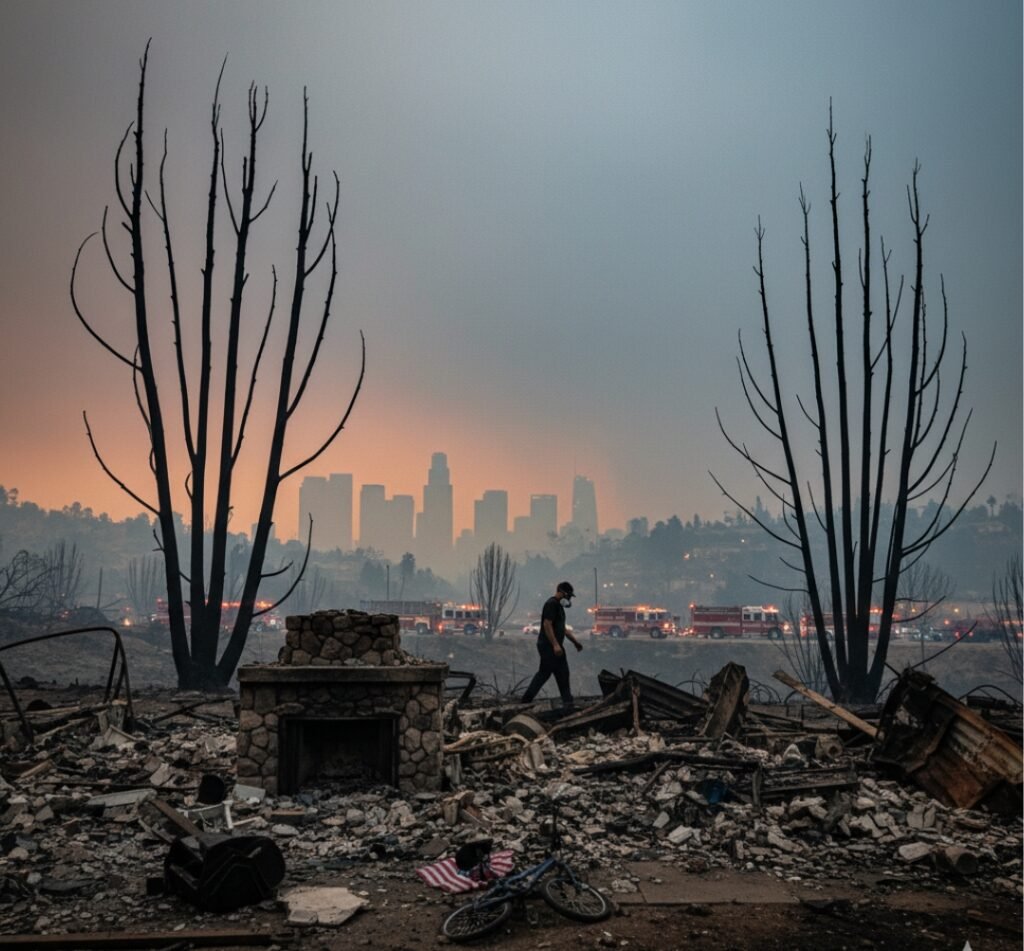As Los Angeles grapples with the aftermath of recent fires, investors are closely monitoring the construction sector, anticipating a surge in demand driven by recovery efforts.
The path forward tests California’s economy and highlights the future of urban development in the face of climate challenges.
Devastation in Altadena and Pacific Palisades
The fires that swept through Altadena and Pacific Palisades in January were catastrophic, reducing over 16,000 buildings to toxic ash. Most were single-family homes, leaving communities displaced and facing the monumental task of rebuilding from scratch.
Tragically, in addition to the loss of homes, local businesses and infrastructure were also severely affected, halting economic activity and leaving many unemployed. Schools, community centers, and parks were not spared either, emphasizing the wide-ranging impact of the disaster.
The environmental toll has also been steep, with significant air and water pollution resulting from debris, ash, and burned chemicals.
Recovery efforts are not only about rebuilding structures but also about addressing these environmental scars. Experts warn that improper cleanup could lead to long-term ecological damage, further complicating the recovery process.
A New Vision for Urban Planning
This tragedy has sparked conversations about rethinking housing in the region. Advocates for denser construction propose rebuilding with multi-family units, townhouses, and mixed-use developments to address housing shortages and create walkable, resilient communities.
By building up, not out, Los Angeles could incorporate advanced fire-resistant materials and redefine home improvement Los Angeles as community-wide redevelopment. Additionally, new building codes may emphasize the importance of defensible spaces, sustainable landscaping, and enhanced water management to mitigate future fire risks.
Urban planners are also advocating for the integration of renewable energy sources, such as solar panels, and energy-efficient designs into the reconstruction process.
This could not only reduce carbon emissions but also pave the way for energy-independent neighborhoods. The tragedy presents an opportunity to align urban development with climate resilience, reshaping Los Angeles into a leader in sustainable city planning.
Challenges to Transforming Los Angeles’ Landscape
Despite the innovation potential, challenges abound. Cultural preferences for single-family homes, zoning laws, and community opposition pose significant hurdles. Many residents wish to rebuild what they had, preserving the character of their neighborhoods.
At the same time, increased costs associated with modern fire-resistant materials and stricter building codes may make rebuilding more expensive for homeowners. These obstacles highlight the importance of striking a balance between tradition and sustainability through thoughtful planning and inclusive community engagement.
City leaders will need to work closely with residents to educate them about the benefits of modern approaches, while also providing financial assistance and incentives to facilitate a smooth transition. Implementing new policies to encourage denser, fire-resistant housing without pricing out existing residents will be a critical challenge.
Economic Implications of Rebuilding
The economic stakes are high. Rising interest rates and affordability issues complicate the rebuilding process amid record-high home prices. Material and labor costs, already steep, could climb higher due to increased demand.
Homeowners face challenges with insurance claims, financing, and contractor selection, while the construction industry faces a logistical test. With over 16,000 buildings to rebuild, delays in material deliveries, skilled labor shortages, and coordination efforts could exacerbate the struggles.
On the positive side, the rebuilding efforts present opportunities for job creation and economic growth in the construction, renewable energy, and urban planning sectors. Local governments may also offer tax incentives to attract investors and developers willing to contribute to innovative, fire-resilient housing solutions.
A Defining Moment for Los Angeles
Rebuilding Los Angeles goes beyond a construction boom—it’s a pivotal moment that will shape the city’s future. The decisions made now will determine how Los Angeles adapts to environmental uncertainty, tests its resilience, and builds safer, smarter, and more equitable communities.
How the city balances the competing demands of affordability, sustainability, and tradition will serve as a model—or a cautionary tale—for other regions facing similar climate challenges. The world will be watching how the city rises from the ashes and what lessons can be drawn for the future.
Tips for Homeowners and Communities Moving Forward
- Focus on Fire-Resistant Materials: When rebuilding, prioritize materials specifically designed to withstand fire, such as fire-resistant roofing, siding, and treated wood. These can significantly reduce the risk of future damage.
- Reevaluate Landscaping Choices: Create defensible spaces by incorporating fire-resistant plants, reducing dense vegetation around your home, and maintaining clean gutters and roofs free of debris.
- Explore Financial Aid Options: Take advantage of state and federal assistance programs designed to help disaster recovery efforts. Research grants, low-interest loans, and insurance options to ease the financial burden.
- Engage in Community Planning: Participate in local rebuilding discussions to advocate for sustainable policies and ensure your community’s voice is heard in shaping the future of your area.
By thoughtfully rebuilding, Los Angeles has the opportunity to emerge stronger, safer, and better prepared for the challenges that lie ahead.
Experienced SEO Specialist and Web Developer with a strong focus on off-page SEO and guest posting. With 3 years of proven expertise, I help businesses improve their search rankings and build sustainable online presence.
